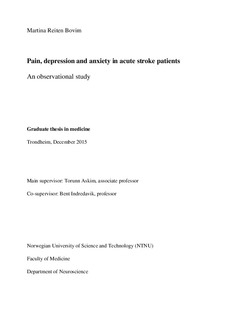| dc.description.abstract | Background: Pain is shown to be quite common in the chronic phase after stroke. Psychological symptoms of depression and anxiety are also considerable problems in the chronic phase, and are associated with impaired functional outcome. However, there are ambiguous results on the prevalence of pain and symptoms of depression and anxiety in the very early phase, and to which extend post stroke pain can be prescribed to the stroke. The primary aim of the present study was to assess the frequency of pain and symptoms of depression and anxiety during the first two weeks after stroke in a group of unselected stroke patients treated in a comprehensive stroke unit with both acute care and early rehabilitation. The secondary aims were to investigate the most common sites for the pain, how pain, depression and anxiety were related to stroke severity and to assess the association between pain, depression and anxiety during the same period. Material and method: Acute stroke patients admitted to the stroke unit at St. Olavs Hospital in Trondheim were eligible for inclusion in this prospective observational study. Patients were followed for two weeks after the stroke. Pain, depression and anxiety were assessed through simple questionnaires once a week. Pain was assessed by the first three items of the Brief Pain Inventory questionnaire, and it was distinguished between pain that occurred prior to the stroke and novel pain that occurred after onset of stroke. Symptoms of depression and anxiety were assessed using the Hospital Anxiety and Depression Scale (HADS). Patients with an early discharge from hospital were contacted by telephone and asked to respond to the questionnaires during follow-up. Results: A total of 222 patients were screened for inclusion and 185 patients were included in the study. Mean (SD) age was 76.9 (8.51), 88 (47.6%) of the patients were women, and mean (SD) score on the Scandinavian Stroke Scale (SSS) was 37.0 (16.40). Of these, 136 were able to respond to the pain questionnaire, and 115 responded to HADS in both weeks. Pain was present in 31 patients (22.8 %) during the first week; 16 patients (11.8 %) claimed that the pain had occurred subsequent to the stroke, while 15 patients (11.0 %) said that the pain had been present before the stoke. A total of 47 patients (34.6 %) experienced pain in the second week, which was significantly more patients compared to the first week, p<0.001. During the first week, 4 patients experienced novel pain in their affected arm. Otherwise pain was most often localized to the head or the neck. Twelve (10.4 %) and 13 (11.3 %) patients scored above cutoff for symptoms of respectively depression and anxiety during the first week. During the second week the numbers were 11 (9.6 %) and 13 (11.3 %) patients. Conclusion: The present study showed that 23% of patients treated in an evidence-based stroke unit experienced pain during the first week after stroke. Half of the reported pain was pain that had occurred before the stroke and the frequency of pain increased significantly from the first to the second week after stroke. New pain was most frequently localized to head or neck. Symptoms of depression and anxiety were also present, but were not more frequent than in the general elderly population reported in other studies. The frequency remained stable during the first two weeks. Few patients with severe strokes were able to respond to the questionnaires; which made it difficult to investigate the association between stroke severity and pain, symptoms of depression or symptoms of anxiety in this study. Future research should explore the relationship between pain, depression and anxiety after stroke more thoroughly, and identify ways of preventing these complications after stroke in the future. | nb_NO |
